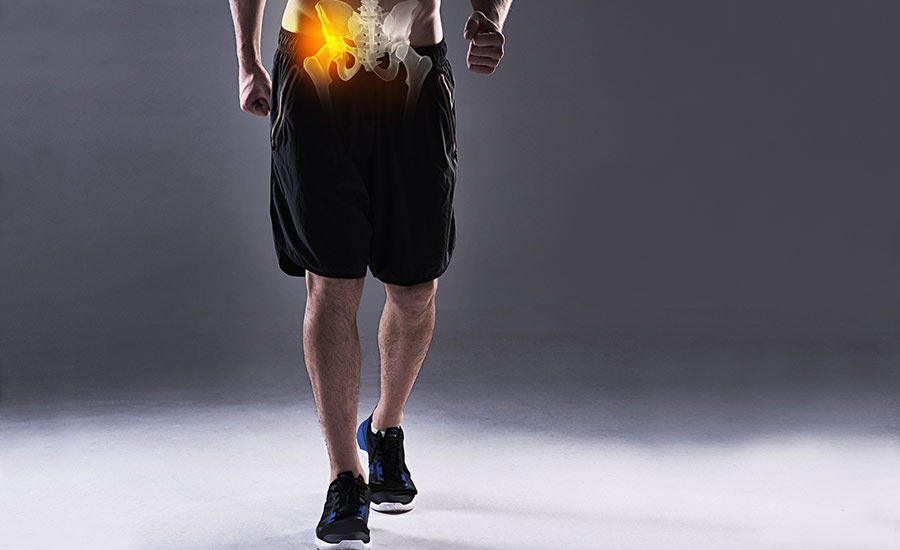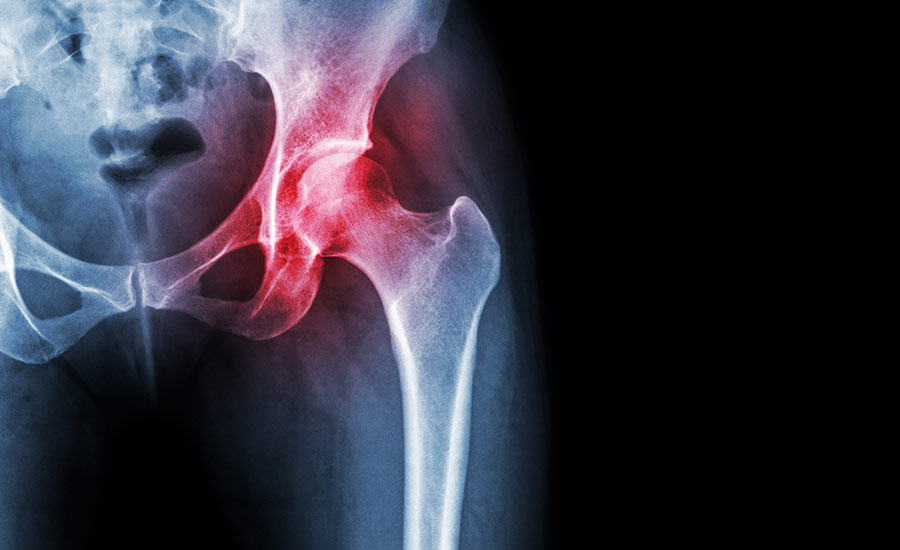
The hip joint, sturdy and enduring as it is, isn’t immune to injury. Whether you’re an elite athlete or part of the senior community, hip discomfort can become an unwelcome companion.
If left untreated, this seemingly minor discomfort can escalate into chronic pain, limit mobility, and severely compromise your quality of life.
This pain may manifest as a sharp, unexpected jolt from a recent injury or the persistent throb of a chronic injury.
We’ll explore the most common hip injuries, take a look at their causes and symptoms, and share the top treatment options available from our orthopedic specialists at OrthoEast.
Most Common Hip Injuries
While there are many different types of hip injuries, the most common include:
Fractures
A hip fracture is a partial break in the bone, which typically occurs in the upper part of the femur or thigh bone. They are common in the elderly due to weakened bones from osteoporosis, but they can occur at any age as a result of high-impact trauma.
The most common types of hip fractures are:
- Intracapsular fractures: This occurs within the joint capsule, the ligamentous structure surrounding your hip joint.
- Extracapsular fractures: These fractures occur outside the hip joint capsule.
In most cases, hip fractures necessitate surgical intervention. However, if the bones have not been displaced, treatment might involve bed rest or pain management.
Soft Tissue Injuries
Soft tissue injuries refer to injuries of the muscles, tendons, ligaments and other connective tissues. Around the hip, these injuries are common and can be both acute (sudden) or chronic (developing over time).
The most common types of soft tissue injuries are:
Muscle strains: These are tears in the muscle fibers and most affected muscles include the hip flexors, adductors and abductors.
Contusions (bruises): Contusions are mostly caused by direct trauma to the hip, leading to bleeding and swelling in the soft tissues.
Tendon injuries: These injuries are caused by inflammation or tears in the tendons surrounding the hip.
Soft tissue injuries require surgery only in the most severe cases, as they can typically be treated with non-operative methods such as rest, physical therapy or pain management techniques.
Bursitis
Bursitis is inflammation of the bursae — small, fluid-filled sacs that act as cushions, to minimize friction between bones and soft tissues like muscles, tendons and skin.
The hip joint is surrounded by several bursae, and when they become inflamed, it can lead to significant discomfort.
Most common types of bursitis are:
- Trochanteric bursitis: This is the most common form of hip bursitis. The bursa, a cushioning sac located at the outer part of the hip known as the greater trochanter, can sometimes get inflamed. When this happens, it can lead to pain on the outside of your hip and thigh.
- Iliopsoas bursitis: This type affects the bursa located on the inside (groin side) of the hip. It’s less common than trochanteric bursitis and may cause pain in the groin area.
Similar to soft tissue injuries, bursitis conditions rarely require surgery and are mainly treated with conservative treatments such as medications, injections or physical therapy.
Labral Tears
Labral tears, often referred to as hip labral injuries, can cause pain and affect hip function.
The labrum is a ring of cartilage that lines the outer rim of the hip socket (acetabulum). Its function is to deepen the socket, stabilize the joint and act as a cushion and seal that helps maintain lubrication inside your joint.
The most common types of labral tears include:
- Radial tear: A tear that extends from the labral base to the free edge, similar to a rip in the tissue.
- Longitudinal peripheral tear: A tear that runs parallel to the acetabulum’s rim.
- Flap tear: A tear in which a portion of the labrum is torn and flips into the joint.
- Degenerative tear: A tear mainly associated with aging, where the labrum becomes frayed and irregular.
Labral tears often require minimally invasive surgery such as hip arthroscopy if the labrum is torn, but tears can also be treated with medication, corticosteroid injections and physical therapy.
Hip Impingement
Hip impingement, also known as femoroacetabular impingement (FAI), is a condition in which there is abnormal contact between the femoral head (the ball) and the acetabulum (the socket) of the hip joint. This can lead to pain, labral injuries and even early osteoarthritis if left untreated.
The most common types of hip impingement include:
- Cam impingement: This results from an abnormal shape or excess bone growth on the femoral head, leading to an irregular or non-spherical shape. This abnormal shape can cause pinching within the joint.
- Pincer impingement: Here, there’s excess bone growth or an over-coverage on the acetabulum (socket), which can pinch or crush the labrum against the femoral head.
Combined: In some cases, both cam and pincer deformities are present, leading to combined impingement.
Tendinitis
Tendinitis, also known as “tendonitis” is the inflammation or irritation of a tendon, which is the thick fibrous cord that attaches muscle to bone.
While tendinitis can develop in any tendon of the body, when referencing the hip, it often pertains to the tendons surrounding this joint.
The most common types of hip tendinitis are:
- Iliopsoas tendinitis: This type of hip tendinitis causes inflammation of the iliopsoas tendon, which is located in the inner hip. Dancers and athletes who perform repetitive hip flexion movements often experience this.
- Gluteal tendinitis: This type of hip tendinitis involves the tendons of the gluteal muscles and is commonly associated with long-standing lower back pain, or conditions like trochanteric bursitis.
Treatment options for tendinitis mainly include non-steroidal anti-inflammatory drugs, physical therapy and corticosteroid injections. Surgery is only necessary in rare cases where the tendon has torn or when other treatments have failed.

Common Causes of Hip Injuries
While some causes of hip injuries might be obvious, like a sudden fall, others may evolve over time, such as degenerative conditions.
The most common causes of hip injuries are:
Falls
One of the leading causes of hip injuries is falls — particularly in the elderly. Falls can result in fractures, dislocation and other traumatic injuries to the hip.
Factors that increase the risk of falls include:
Age-related muscle weakness and decreased balance
Medications that affect coordination or balance
Vision problems, such as cataracts, glaucoma, or age-related macular degeneration
Osteoporosis, making bones more fragile and prone to fractures
Sports & Physical Activities
Engaging in sports and physical activities is beneficial for health, but it can also present risks for hip injuries. Sports that require repetitive motion, like running, cycling, or dance, often result in overuse injuries, such as:
Labral tears
Hip flexor strains
Hip dislocations or fractures, especially in contact sports
Groin pulls or strains
Hip impingement from repetitive motions
Overuse or Repetitive Strain
If you’re an athlete executing the same moves or an employee performing repetitive tasks, consistently stressing the hip joint in similar ways can eventually result in injuries.
Overuse or repetitive strain can cause:
Tendinitis from continuous strain on tendons
Stress fractures in runners or jumpers
Bursitis from frequent friction over the hip joint
Muscle strains from continuous overstretching
Degenerative Conditions
Over time, wear and tear on the hip joint can lead to degenerative conditions that compromise its integrity, such as:
Osteoarthritis, in which the cartilage in the hip joint wears down
Rheumatoid arthritis, which is an autoimmune disorder that causes joint inflammation
Hip labral tear, often due to age-related wear
Bone Diseases
Certain diseases can weaken the bone structure, making the hip more susceptible to injuries.
These include:
Osteoporosis, in which the bones become brittle and porous
Paget’s disease of the bone, which causes bones to enlarge and weaken
Bone tumors or cancers, which compromise bone strength and integrity
Hip Injury Symptoms
Recognizing the symptoms of hip injuries is crucial for timely diagnosis and treatment. Early detection can prevent potential complications, reduce the risk of long-term damage and ensure a more stable recovery process.
The most common hip injury symptoms are:
- Pain: Typically originating in the hip or groin area, pain can often radiate to the thigh, lower back, or buttocks. The sensation might feel sharp and sudden, indicating an acute injury, or it could be a dull and chronic pain, hinting at an ongoing issue or condition.
- Stiffness: If your hip feels tight and doesn’t move as easily, it might be inflamed, or there could be some wear and tear inside. This often makes certain positions uncomfortable or hard to achieve.
- Swelling and tenderness: Swelling around the hip and soreness when you touch it typically indicates inflammation. Conditions like bursitis or tendinitis are common culprits.
- Reduced range of motion: Trouble lifting your leg or feeling limited in twisting your hip can indicate issues like hip impingement or a tear in the soft tissue within the hip.
- Audible symptoms: If your hip starts making unusual noises like snaps or grinds, it can indicate damage or structural changes inside.
- Muscle weakness or atrophy: If the muscles near your hip feel weaker or look smaller, it could be due to underuse or a deeper issue that’s affecting how your hip functions.

When To See a Specialist for Hip Pain
If you’re suffering from a hip injury, it’s time to see a specialist if you’re experiencing:
- Persistent pain: If your discomfort doesn’t subside after several days of home remedies and rest, it’s wise to seek an assessment.
- Severe pain following trauma: A sharp, intense pain after an incident like a fall could indicate serious injuries.
- Limitations in mobility: If you find moving your hip increasingly difficult or painful, especially in daily activities, you will need help in pinpointing the potential issue.
- Pain interrupting sleep: Nightly discomfort might signal a more severe condition.
- Failure of initial treatments: If over-the-counter solutions are not working as expected, our OrthoEast specialists can help determine a tailored approach for your specific situation
Hip Pain Treatment at OrthoEast
OrthoEast stands as a top-tier destination for exceptional orthopedic care. As a team of board-certified specialists, we are committed to providing personalized care for each patient.
At OrthoEast, our hip experts prioritize conservative treatments when diagnosing and providing treatment strategies.
Our conservative approach includes treatments such as:
- Over-the-counter pain relievers
- Prescription medications
- Topical pain relievers
- Corticosteroid injections
- Relative rest
- Splint
- RICE
Every specialist on the team is not only board-certified but also possesses advanced fellowship training in orthopedic care. We are dedicated to tailoring treatment plans to individual patient needs.
If you are experiencing persistent hip pain that seems resistant to initial non-invasive measures, our orthopedic and pain management specialists are here to guide you toward the most effective treatment alternatives. Our orthopedic specialists are skilled in:
In addition to total and partial hip replacements, we also offer various procedures for pain relief and holistic joint care. This includes specialized hip surgeries for those battling conditions like hip dysplasia and arthritis.
We are committed to finding out what’s causing your pain to determine a treatment for long-term relief.
Our state-of-the-art facilities are conveniently located across New Jersey and New York.
Contact us to meet our esteemed hip specialists, Dr. Craig Wright, Dr. Casey Pierce, Dr. William Matarese, Dr. Anthony Scilia, and Dr. Thomas Novack, and let us create a treatment plan to help you find pain relief.



